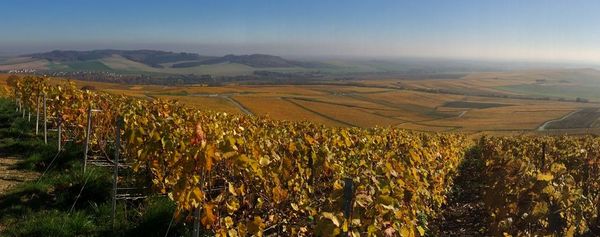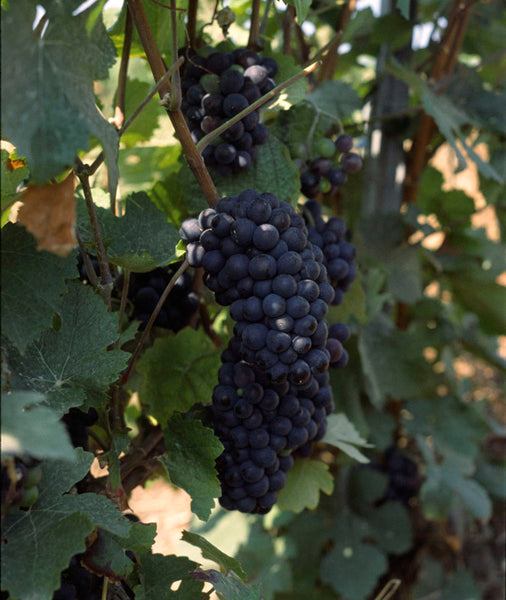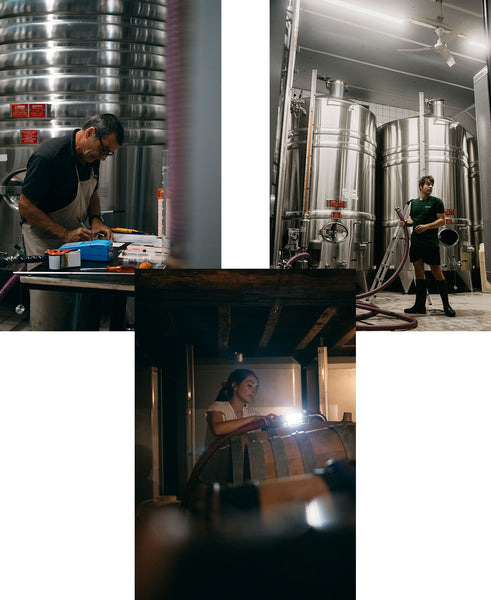“This set of current releases from Hébrart is superb. The entry-level bottlings are delicious and very good values, while the higher-end Champagnes are incredibly distinctive.” -- Antonio Galloni, Vinous Media

Champagne Marc Hébrart
Jean-Paul Hebrart

The epitome of balance. Always easy to drink, but sneakily layered with the complexity and concentration that can only be achieved by farming some of the best terroir in the country.
France

(By Archimatth - File:Vignobles_France.svg, CC BY-SA 2.5, https://commons.wikimedia.org/w/index.php?curid=37093378)
Champagne


Grande Vallée, Côte des Blancs & Montagne de Reims
- Maureil-sur-Aÿ, 1er Cru - Grande Vallée
- Avenay-Val-d’Or, 1er Cru - Grande Vallée
- Bisseuil, 1er Cru - Grande Vallée
- Dizy, 1er Cru - Grande Vallée
- Aÿ, Grand Cru - Grande Vallée
- Avize, Grand Cru - Côte des Blancs
- Chouilly, Grand Cru - Côte des Blancs
- Oiry, Grand Cru - Côte des Blancs
- Louvois, Grand Cru - Montagne de Reims
15 hectares
- Pruche, in Aÿ, a lieu-dits, planted with Pinot Noir and part of the Rive Gauche Rive Droite and Noces de Craie wines
- Cheuzelles, in Aÿ, a lieu-dits, planted with Pinot Noir and part of the Rive Gauche Rive Droite and Noces de Craie wines
- Longchamps, in Aÿ, a lieu-dits, planted with Pinot Noir and part of the Rive Gauche Rive Droite and Noces de Craie wines
- Chaffour, in Aÿ, a lieu-dits, planted with Pinot Noir and part of the Rive Gauche Rive Droite and Noces de Craie wines
- Pierre Robert, in Aÿ, a lieu-dits, planted with Pinot Noir and part of the Noces de Craie wine
- Léon, in Dizy, a clos Hébrart makes a single vineyard wine from
- Noyer La Ville, in Mareuil-sur-Aÿ, a lieu-dits that sits next to the Clos des Goisses
- Les Côtes, in Mareuil-sur-Aÿ, a lieu-dits that sits next to the Clos des Goisses
- Faubourg d’Enfer, in Mareuil-sur-Aÿ, a lieu-dits used in the Special Club bottling
- Côte, in Mareuil-sur-Aÿ, a lieu-dits used in the Special Club bottling
- Haut de Varille, in Mareuil-sur-Aÿ, a lieu-dits used in the Special Club bottling
- Croix Blanches, in Mareuil-sur-Aÿ, a lieu-dits used in the Special Club bottling
- Sente des Demoiselles, in Mareuil-sur-Aÿ, a lieu-dits used in the Special Club bottling
- Montaigu, in Chouilly, part of the Special Club blend
- La Justices, in Oiry, part of the Special Club blend
Cold Continental
- This was the northern edge of viticulture until recent decades
- 2nd most northern grape growing region in France, after Alsace, but much less sunshine and more rain.
- Harsh cold winters, short hot summers
- Rain in summer, snow in winter
- Very wet climate, although drought has been an issue in recent vintages because of climate change
- Viticulture is possible because of long, (hopefully) dry, temperate autumns to extend the growing season.
- Because ripeness was a struggle, grapes are usually grown for white wine, or in the last 150 years, sparkling wines.
- Variations between his sites are due to aspect, elevation and proximity to water, like the Marne river.
- Cool climate red varieties Pinot Noir and Pinot Meunier dominate, but the vast majority are destined for white or rosé sparkling wines.
- Wines are going to be high in acidity, light in body, low in alcohol, and often need extended aging of 18 months or more to temper the high acidity.
- Sugar is often added to wines at the end, called dosage, to help balance the high acidities from cold climate grapes.
- Pinot Noir, 70%
- Critical for structure and body, more powerful than the other two grapes
- Fruit profile can include red apple, strawberry, apricot, and peach
- Savory notes of spices, stones, rose petal and violet
- Almost always the grape used for rosé Champagne
- Shows best in on south facing sites with clay over chalk

- Chardonnay, 30%
- Adds finesse and freshness
- Often a signature lemon meringue pie flavor profile.
- If handled reductively, can impart white flower, ginger, green apple, quince and other primary flavors
- Oxidative or aged examples can be full of brioche, kernel, honey and truffle
- Does best in east facing sites with little to no top soil on chalk and other limestones

Sustainable
- Works with organic composts
- Avoids synthetic treatments as much as possible
- Yields are kept in check by rubbing out every other bud, rather than green harvesting

Traditional
- Uses two membrane presses
- Vinifies everything separately
- Ferments most wines in enameled steel tanks and stainless steel
- Some old-vine parcels are vinified in barrel
- Fermentation at cool temperatures
- Some indigenous yeast ferments
- Most wines are allowed to go through malolactic fermentation
- Wines are disgorged at least 6 months before shipping to allow them to settle.

Jean-Paul took over the estate in 1997, from his father who started bottling the family's grapes in 1964. He’s one of the most soft spoken, thoughtful and kind vignerons I’ve met, and that subtly finds its way into his wines.
Hébrart has holdings in a number of top sites in both the Vallée de la Marne and the Côte des Blancs but is a specialist in the super-premier-cru village of Mareuil-sur-Aÿ, where you find top spots like the Clos des Goisses and Selosse’s Sous le Mont.
When he blends his top cuvées, he has a lot of great source material to choose from but even Hébrart’s entry-level wines are pitched absolutely perfectly.
He is a member of Les Club Tresors, or the Special Club and Les Artisans du Champagne.
"Hébrart’s wines have a broad appeal: if you like to think about your wines, they’re intellectually engaging enough to satisfy you; on the other hand, if you’re just looking to drink, they’re simply delicious." - Peter Liem, Champagne Guide
They're elegant and complex, and will elevate any dish. But they're not flashy or over the top: more supporting players than show-boaters.
These are the wines I recommend to those who’ve only ever drunk Veuve Clicquot’s yellow label and are ready to dive into the world of “real Champagne”. Balance is the name of the game, not too heavy, not too light, not too tart, not too sweet, but just what we all want to drink.
Mes Favorites is aptly named, as it is always one of my favorite Champagnes, period.
Marc Hébrart, Champagne Sélection Brut, NV $61.99 $54.55
Marc Hébrart, Champagne Sélection Brut, NV (375ml) $37.99 $33.43
Marc Hébrart, Champagne Sélection Brut, NV (1.5L) $144.99 $127.59
"The NV Brut Sélection is based on 2018, with reserve wines from 2016 and 2015. Richness and vibrancy come together in a mid weight Champagne that captures the essence of Hébrart's style. Lemon confit, apple tart, spice, chamomile and dried flowers build into the resonant finish. Disgorged: March, 2022. 91 pts" -- By Antonio Galloni
Marc Hébrart, Champagne Blanc de Blancs Brut, NV $61.99 $54.55
"The NV Brut Blanc de Blancs is built on a base of fruit from Mareuil, with dollops of Oiry and Chouilly. It offers good up front intensity and almost Pinot-like expression of breath. Plum, lemon confit, spice and dried flowers all open effortlessly. The mid-palate and finish lose some of that initial exuberance, and yet there is plenty to admire here. All things considered, this is a solid value. Disgorged: November 23, 2021. 90 pts" -- By Antonio Galloni
Marc Hébrart, Champagne Cuvée de Réserve Brut, NV $61.99 $54.55
"The NV Brut Cuvée de Réserve is an engaging Champagne from Marc Hébrart. It offers up an enticing mix of red plum, spice, mint and dried flowers. Pinot Noir drives the blend in terms of flavor profile and overall structure. The only thing this could benefit from is a bit more polish, as the contours are pretty angular. Then again, this is the NV offering. Disgorged: November 21, 2021. 89 pts" -- By Antonio Galloni
Marc Hébrart, Champagne Rosé Brut, NV $67.99 $59.83
"The NV Brut Rose is a pleasant, easygoing, aperitif-style Rosé to drink now and over the next few years. Crushed red berry fruit, white pepper and bright floral top notes give this pale-colored Rosé lovely complexity to match its delicate, understated personality. The blend is 55% Chardonnay and 45% Pinot Noir, all from Mareuil. Disgorged: March 16, 2022. 89 pts" -- By Antonio Galloni
Marc Hébrart, Champagne Rosé Extra Brut, NV (1.5L) $164.99 $145.19
"...Hébrart's NV Extra-Brut Premier Cru Rosé offers up notes of red apple, pear, fresh pastry and Meyer lemon. Medium to full-bodied, bright and pillowy, with racy acids and a pinpoint mousse, it's crisp and precise, with a charming core of fruit. This is another cuvée where the transition from brut to extra-brut really allows the quality of the fruit to shine. 91 pts" -- William Kelley, The Wine Advocate
Marc Hébrart, Champagne Mes Favorites Vieilles Vignes Brut, NV $77.99 $68.63
"The NV Brut Mes Favorites Villes Vignes is a powerful, structured Champagne. There's plenty of old-vine intensity and bright acid driving a core of Pinot-based fruit. I would prefer to cellar this for at least another year or two, as it is clearly still coming together. It's a wine for readers who enjoy rich, vinous Champagnes at the dinner table. Disgorged: April 27, 2021. 92 pts" -- By Antonio Galloni
Marc Hébrart, Côteaux Champenois Blanc Le Leon 1er Cru, 2016 $98.99 $87.11
"This is Hébrart’s first release of Coteaux Champenois, vinified in barrel without malolactic and aged for 18 months on its fine lees. It’s all from the Dizy vineyard of Le Léon, although it doesn’t state this on the label, and it’s deliciously forward and inviting, marked by a refined texture and an elegant build. While it doesn’t have the depth or richness of Hébrart’s champagnes, it feels harmonious and expressive of place, and it will be intriguing to compare this with the champagnes made from the same site. Last tasted: 3/20" – Peter Liem Champagneguide.net
Marc Hébrart, Champagne Spécial Club Brut, 2019 $114.99 $101.19
Marc Hébrart, Champagne Spécial Club Brut, 2017 (1.5L) $220.00 $193.60
"The 2017 Brut Spécial Club ler Cru is a very classy, understated Champagne. Soft, silky contours, lifted aromatics and an exceptionally fine mousse are some of the signatures. Tasted from magnum, the 2017 is an absolute delight. It is one of the most elegant wines I have tasted from Marc Hébrart. The 2017 is just a bit light, but its balance is beyond reproach. It has enough freshness to drink well for at least a number of years. Tasted from magnum. Disgorged: January 18, 2022. 93 pts" -- By Antonio Galloni
Marc Hébrart, Champagne Noces de Craie Extra Brut, 2016 $129.99 $114.39
"Disgorged in January 2021, Hébrart's 2016 Extra-Brut Blanc de Noirs Grand Cru Noces de Craie wafts from the glass with expressive aromas of stone fruits, green mango, confit citrus and buttery pastry. Medium to full-bodied, rich and fleshy, it's a vibrant but gourmand wine with a generous, enveloping profile and a fine, pillowy mousse that's true to its Aÿ origins. This is a gastronomic Champagne that would go well with food. 94 pts" -- William Kelley, The Wine Advocate
Marc Hébrart, Champagne Rive Gauche-Rive Droite Grand Cru Brut, 2013 $148.99 $131.11
"Disgorged in May 2019, Hébrart's 2013 Extra-Brut Grand Cru Rive Gauche – Rive Droite is showing beautifully, wafting from the glass with aromas of pear, quince, nougat, white flowers and brioche. Medium to full-bodied, vinous and layered, with a deep core of fruit, racy acids and a pillowy mousse, it's concentrated and precise, with a seamless, elegant profile. Hébrart is going from strength to strength, and this cuvée exemplifies that. 94 pts" -- William Kelley, The Wine Advocate
Marc Hébrart, Champagne Rive Gauche-Rive Droite Grand Cru Brut, 2012 (1.5L) $390.00 $343.20
"Tasted from a bottle disgorged in January 2018, the 2012 Extra Brut Grand Cru Rive Gauche – Rive Droite offers up aromas of green pear, blanched almonds and crisp fresh apricots and is less marked by its barrel fermentation than some of Hébrart's earlier renditions of this cuvée. On the palate, the wine is medium to full-bodied, ample and precise, with ripe but tangy acids, an elegantly textural attack and an ultra-fine mousse. Its charming, inviting quality is typical of Hébrart's style. 93 pts" -- William Kelley, The Wine Advocate
Marc Hébrart, Champagne Clos de Leon 1er Cru Brut, 2014 $190.00 $167.20
Marc Hébrart, Champagne Clos de Leon 1er Cru Brut, 2014 (1.5L) $410.00 $360.80
"Disgorged April 2021, Hébrart's 2014 Extra-Brut Blanc de Blancs Clos Léon wafts from the glass with aromas of pear, frangipane, freshly baked bread, nectarine and white flowers. Medium to full-bodied, deep and fleshy, it's vinous and enveloping, with racy acids and a pretty pinpoint mousse, concluding with a long, expansive finish. It's typical of Hébrart's charming style. 94 pts" -- William Kelley, The Wine Advocate



















































































































